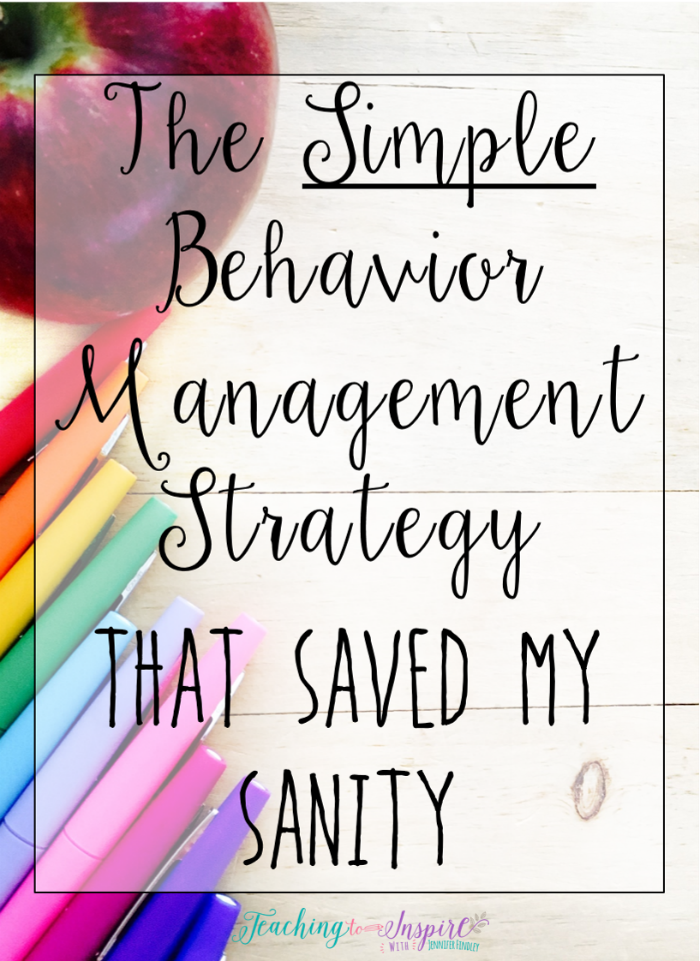I spent my first four years of teaching in an inner city, rough area. The students I taught had dealt with and experienced things that young children (or anyone for that matter) should never experience.
With that type of environment often comes major discipline problems. I have never had a problem with classroom management over all, but there were definitely times when I was caught off guard and at a loss for how to handle a situation. I have had students roll their eyes at me, sling objects off desks, and say quite vulgar things to one another. Needless to say, this type of behavior can rattle even the most experienced teacher.
My first principal instilled in me the importance of being fair, firm, and consistent with my behavior management. But even with this, I still had moments where I had to respond quickly to an outburst or behavior, and hope I was responding in the best way. To combat this as much as possible I started using this very simple (almost too simple) behavior management strategy to get me through even the most difficult classes.
I am going to warn you.. this is pretty simple, but it really has worked wonders. Basically, I make a list of all the behaviors that can occur and I make a “If… then…” statement for each behavior. If a student throws a piece of paper, then this happens. If a student is on a different browser instead of the computer assignment, then this happens. If a student refuses to get a pencil from the pencil jar when they need one, this happens.
Anytime I introduced a new activity or we had something new going on that day, I would quickly run through all the possible behaviors that could happen and come up with reasonable and logical “If… then…” statements for how to handle the behavior.
To take this strategy even further to maximize effectiveness, we discuss the majority of these “If… then…” statements as a class. This way the students know exactly what is expected of them and exactly what would happen if they misbehaved.
Sometimes these “then” statements that I generate are not consequences but more how I will respond to the behavior. This keeps me calm and confident when an extreme or disrespectful behavior occurs.
An example of this is when a student was starting a time test early and refused to turn the paper over and wait. I had honestly never experienced this before and this student cared about his/her grade. I don’t think I handled the situation as appropriately as I should because I was caught off guard. Now that this has happened, I have an appropriate “then” prepared. (I will calmly say to the student, “This is a timed test. If you begin early, that is considered cheating and a zero will be given.”- I know that may seem super obvious to some as the immediate response but with this student, I was completely thrown off guard and didn’t immediately know how to respond).
Practicing this strategy doesn’t ensure that I am never caught off guard, because it is impossible to predict all of the behaviors that students will do throughout the course of a school year (or day for that matter). However, by creating these “If… then…” statements I was prepared for the majority of behaviors that would occur.
Now why is this strategy so important and how did it save my sanity? This strategy was crucial to my behavior management plan (and my classroom community) because it allowed me to be fair, firm, and consistent at all times with all students. I was prepared to handle the majority of behaviors quickly and without being flustered or visibly upset.
This also kept me from taking student behaviors personally, which I was very guilty of doing the first year or so of teaching (and occasionally I still have to remind myself that it is not personal). This strategy also helped me to create a classroom culture of mutual respect and caring that many of my students had not previously experienced. They began to thrive in this type of environment, and behavior problems decreased as a result.
To be honest, I didn’t realize just how important this strategy was to my behavior management until I had a year where I had very few behavior problems and little need for the strategy. The next year, I had several students who were prone to misbehavior. I quickly realized I needed to revisit this strategy and put it back in place quickly. Once I did, it was like a night and day transformation in my classroom.
What do you think of this simple behavior management strategy? Is this something you do already?







